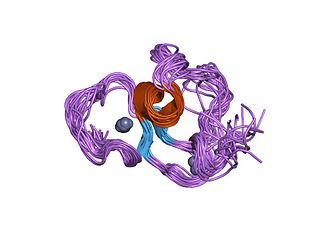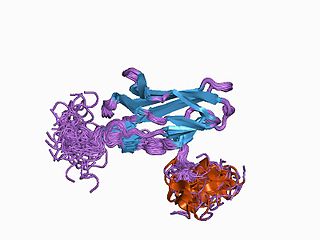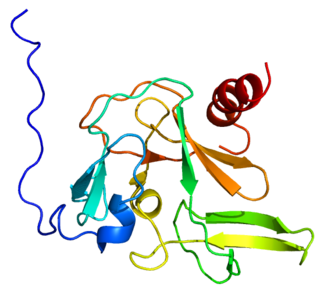Lysine-specific demethylase 5A is an enzyme that in humans is encoded by the KDM5A gene. [5] [6]
Lysine-specific demethylase 5A is an enzyme that in humans is encoded by the KDM5A gene. [5] [6]
The protein encoded by this gene is a ubiquitously expressed nuclear protein. It binds directly, with several other proteins, to retinoblastoma protein which regulates cell proliferation. It was formerly known as Retinoblastoma Binding Protein 2 (RBP2). This protein also interacts with rhombotin-2 which functions distinctly in erythropoiesis and in T-cell leukemogenesis. Rhombotin-2 is thought to either directly affect the activity of the encoded protein or may indirectly modulate the functions of the retinoblastoma protein by binding to this protein. Alternatively spliced transcript variants encoding distinct isoforms have been found for this gene. [6]
The Drosophila homolog, LID, was found to be an H3K4 histone demethylase that binds to c-Myc. [7] It was recently renamed to Lysine Demethylase 5 (KDM5).
Enzymatically can be designated as a trimethyllysine dioxygenase, which is a member of the alpha-ketoglutarate-dependent hydroxylase superfamily (EC 1.14.11.8).
JARID1A has been shown to interact with Estrogen receptor alpha, [8] LMO2 [9] and Retinoblastoma protein. [8] [10]
JARID1A is a major component of the circadian clock, the upregulation of which at the end of the sleep phase blocks HDAC1 activity. Blocking HDAC1 activity results in an upregulation of CLOCK and BMAL1 and consequent upregulation of PER proteins. The PSF (polypyrimidine tract-binding protein-associated splicing factor) within the PER complex recruits SIN3A, a scaffold for assembly of transcriptional inhibitory complexes and rhythmically delivers histone deacetylases to the Per1 promoter, which repress Per1 transcription. [11] [12]
Knockdown of JARID1A promoted osteogenic differentiation of human adipose-derived stromal cells in vitro and in vivo and resulted in marked increases of mRNA expression of osteogenesis-associated genes such as alkaline phosphatase (ALP), osteocalcin (OC), and osterix (OSX). RBP2 was shown to occupy the promoters of OSX and OC to maintain the level of the H3K4me3 mark by chromatin immunoprecipitation assays. RBP2 was also physically and functionally associated with RUNX2, an essential transcription factor that governed osteoblastic differentiation. RUNX2 knockdown impaired the repressive activity of RBP2 in osteogenic differentiation of human adipose-derived stromal cells. [13]

Protein c-Fos is a proto-oncogene that is the human homolog of the retroviral oncogene v-fos. It is encoded in humans by the FOS gene. It was first discovered in rat fibroblasts as the transforming gene of the FBJ MSV. It is a part of a bigger Fos family of transcription factors which includes c-Fos, FosB, Fra-1 and Fra-2. It has been mapped to chromosome region 14q21→q31. c-Fos encodes a 62 kDa protein, which forms heterodimer with c-jun, resulting in the formation of AP-1 complex which binds DNA at AP-1 specific sites at the promoter and enhancer regions of target genes and converts extracellular signals into changes of gene expression. It plays an important role in many cellular functions and has been found to be overexpressed in a variety of cancers.

Runt-related transcription factor 2 (RUNX2) also known as core-binding factor subunit alpha-1 (CBF-alpha-1) is a protein that in humans is encoded by the RUNX2 gene. RUNX2 is a key transcription factor associated with osteoblast differentiation.
Demethylases are enzymes that remove methyl (CH3-) groups from nucleic acids, proteins (in particular histones), and other molecules. Demethylase enzymes are important in epigenetic modification mechanisms. The demethylase proteins alter transcriptional regulation of the genome by controlling the methylation levels that occur on DNA and histones and, in turn, regulate the chromatin state at specific gene loci within organisms.

The PHD finger was discovered in 1993 as a Cys4-His-Cys3 motif in the plant homeodomain proteins HAT3.1 in Arabidopsis and maize ZmHox1a. The PHD finger motif resembles the metal binding RING domain (Cys3-His-Cys4) and FYVE domain. It occurs as a single finger, but often in clusters of two or three, and it also occurs together with other domains, such as the chromodomain and the bromodomain.

Histone deacetylase 1 (HDAC1) is an enzyme that in humans is encoded by the HDAC1 gene.

Runt-related transcription factor 1 (RUNX1) also known as acute myeloid leukemia 1 protein (AML1) or core-binding factor subunit alpha-2 (CBFA2) is a protein that in humans is encoded by the RUNX1 gene.

Histone deacetylase 3 is an enzyme encoded by the HDAC3 gene in both humans and mice.

Retinoblastoma-like protein 2 is a protein that in humans is encoded by the RBL2 gene.

Histone-binding protein RBBP4 is a protein that in humans is encoded by the RBBP4 gene.

LIM domain only 2, also known as LMO2, RBTNL1, RBTN2, RHOM2, LIM Domain Only Protein 2, TTG2, and T-Cell Translocation Protein 2, is a protein which in humans is encoded by the LMO2 gene.

Retinoblastoma-like 1 (p107), also known as RBL1, is a protein that in humans is encoded by the RBL1 gene.

PR domain zinc finger protein 2 is a protein that in humans is encoded by the PRDM2 gene.

Lysine-specific demethylase 4A is an enzyme that in humans is encoded by the KDM4A gene.

AT rich interactive domain 4A (RBP1-like), also known as ARID4A, is a protein which in humans is encoded by the ARID4A gene.

Lysine-specific demethylase 5C is an enzyme that in humans is encoded by the KDM5C gene. KDM5C belongs to the alpha-ketoglutarate-dependent hydroxylase superfamily.

Lysine-specific demethylase 5B also known as histone demethylase JARID1B is a demethylase enzyme that in humans is encoded by the KDM5B gene. JARID1B belongs to the alpha-ketoglutarate-dependent hydroxylase superfamily.

Protein Jumonji is a protein that in humans is encoded by the JARID2 gene. JARID2 is a member of the alpha-ketoglutarate-dependent hydroxylase superfamily.

In molecular biology, miR-137 is a short non-coding RNA molecule that functions to regulate the expression levels of other genes by various mechanisms. miR-137 is located on human chromosome 1p22 and has been implicated to act as a tumor suppressor in several cancer types including colorectal cancer, squamous cell carcinoma and melanoma via cell cycle control.

Short-stature homeobox 2, also known as homeobox protein Og12X or paired-related homeobox protein SHOT, is a protein that in humans is encoded by the SHOX2 gene.

The retinoblastoma protein is a tumor suppressor protein that is dysfunctional in several major cancers. One function of pRb is to prevent excessive cell growth by inhibiting cell cycle progression until a cell is ready to divide. When the cell is ready to divide, pRb is phosphorylated, inactivating it, and the cell cycle is allowed to progress. It is also a recruiter of several chromatin remodeling enzymes such as methylases and acetylases.
This article incorporates text from the United States National Library of Medicine, which is in the public domain.